31 июля 2013, 18:23
Fed Tapering: не сегодня, так завтра
Доходность UST10 vs. упоминания “Fed Tapering”
“Tapering” – это термин, который окончательно вошел в финансовый лексикон 22 мая 2013 года, когда председатель ФРС Бернанке, выступая перед Конгрессом, заявил, что Фед может сократить (taper) программу выкупа активов (QE) в ближайшие месяцы.
Однако первые упоминания сочетания “Fed Taper” начали появляться еще в апреле. Количество упоминаний этой фразы сегодня плотно коррелирует с динамикой доходности 10-летних трежериз – бенчмарка долгового рынка США. Доходность UST10 проделала внушительный путь с 1,6% в мае до 2,6% в июле. И вместе с обновлением новых исторических максимумов по индексу S&P 500 (+18% YTD), активно продвигаемая западными инвестдомами концепция “Great Rotation” теперь в полной мере реализуется.
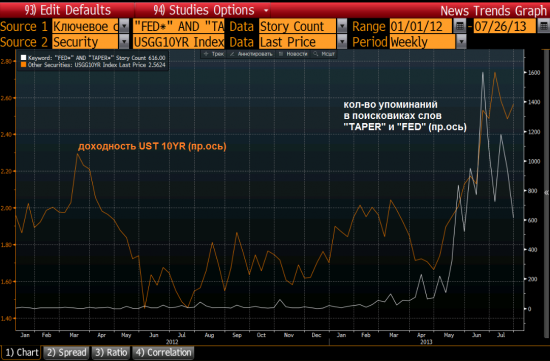 Источник: Bloomberg
Источник: Bloomberg
Ожидания по Fed Tapering
Согласно опросам Bloomberg с 17 по 22 июля, никто из опрошенных 54 экономистов не ждет сокращения программы QE3 по итогам заседания ФРС 30-31 июля. При этом 50% из опрошенных респондентов считают, что ФРС начнет менять объем QE3 на заседании 17-18 сентября 2013 года, 28% — на заседании 17-18 декабря. При этом экономисты указывают, что ФРС сократит объем выкупа MBS на $10 млрд в месяц с текущих $40 млрд в месяц, трежериз – на $10 млрд в месяц с текущих $45 млрд в месяц.
50% экономистов сказали, что ожидают полного завершения QE3 во втором квартале 2014 года, 24% — в третьем квартале 2014 года.
40% респондентов отметили, что текущая политика монетарных властей в разрезе мягкости/жесткости является “правильной” (just right), 36% — достаточно мягкой (somewhat too easy).
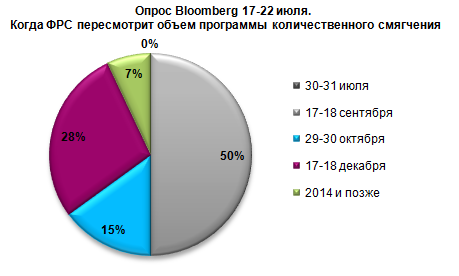
Баланс ФРС vs. S&P 500
Каким образом может сказаться сокращение QE3 на динамике S&P 500? Ответ может крыться в следующем.
C ноября 2008 года, когда ФРС запускал свои первые программы по стимулированию экономики, по текущий момент корреляция между объемом активов на балансе регулятора и динамикой индекса S&P 500 составила более 90% (R2 = 83,4%).
 Источник: Bloomberg
Источник: Bloomberg
Fed’s Forward guidance
Сегодня forward guidance — это один из ключевых инструментов монетарной политики ФРС. Роль этого инструмента будет только возрастать. Рынок будет вчитываться в каждое слово протоколов заседаний FOMC и будет еще более чувствительным к заявлениям Бернанке и Co.
ФРС уже недвусмысленно обозначил важность стабильности на финансовом рынке. Потому, ограничивая QE, регулятору необходимо обязательно дать что-то “взамен”. Это может быть пролонгация ZIRP на более отдаленный срок, это может быть пересмотр ранее обозначенных параметров по безработице (6,5%) и инфляции (2%±0,5%)… это может быть что угодно, но это должно убедить рынок. ФРС уже недвусмысленно обозначил важность стабильности на финансовом рынке. ФРС должен стать к нему еще ближе.
По факту последнего заседания forward guidance членов FOMC выглядят следующим образом:
— прогнозы по ВВП США:

— прогнозы по уровню процентных ставок и тайминг:
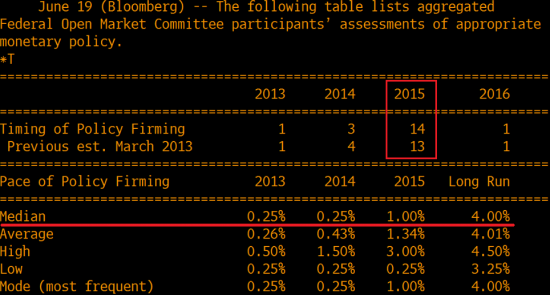
Влияние “Fed Tapering” на глобальные рынки
Сокращение программы выкупа активов QE3 ознаменует окончание глобальной эры дешевого доллара и дешевого фондирования.
Ниже представлена динамика гособлигаций развитых (DM) и развивающихся (EM) рынков с 14 мая 2013 года, когда неголосующий член FOMC Плоссер заявил о необходимости сокращения программы QE. Обратите внимание на максимальные и минимальные значения в доходностях, и на голубые круглые указатели в диапазоне, которые сегодня выше средних значений за указанный период (т.е. ближе к максимальным значениям).
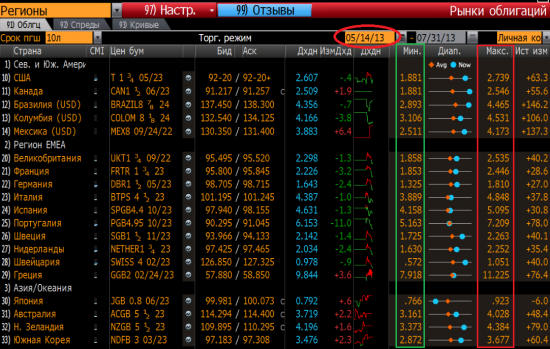
Вот так изменились доходности государственных, корпоративных и др. типов долговых бумаг по всему миру с начала года. Рост по всему спектру. И все это во многом на ожиданиях сокращения программы выкупа активов со стороны ФРС США.
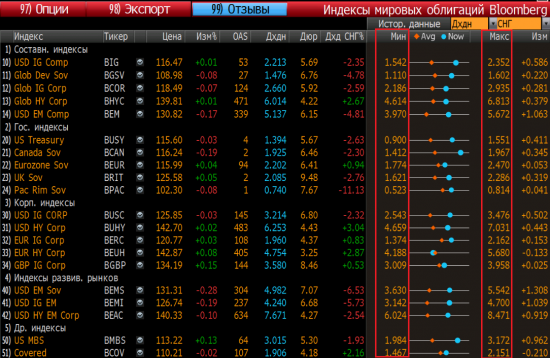
+ Bonus. Сравнение сопроводительных заявлений FOMC
Сравнение публикаций сопроводительных заявлений Комитета по Открытым Рынкам ФРС США от 19 июня и 1 мая 2013 года. Зачеркнутым шрифтом выделены слова текста протокола от 1 мая, которые были заменены словами, выделенными жирным курсивом. Жирным шрифтом выделены решения по QE3, жирным подчеркунтым — условиям проведения политики ZIRP:
Information received since the Federal Open Market Committee met in MarchMay suggests that economic activity has been expanding at a moderate pace. Labor market conditions have shown somefurther improvement in recent months, on balance, but the unemployment rate remains elevated. Household spending and business fixed investment advanced,and the housing sector has strengthened further, but fiscal policy is restraining economic growth. InflationPartly reflecting transitory influences, inflation has been runningsomewhat below the Committee’s longer-run objective, apart from temporary variations that largely reflect fluctuationsin energy prices. Longerbut longer-term inflation expectations have remained stable.
Consistent with its statutory mandate, the Committee seeks to foster maximum employment and price stability. The Committee expects that, with appropriate policy accommodation, economic growth will proceed at a moderate pace and the unemployment rate will gradually decline toward levels the Committee judges consistent with its dual mandate. The Committee continues to seesees the downside risks to the economic outlook for the economy and the labor market as having diminished since the fall. The Committee also anticipates that inflation over the medium term likely will run at or below its 2 percent objective.
To support a stronger economic recovery and to help ensure that inflation, over time, is at the rate most consistent with its dual mandate, the Committee decided to continue purchasing additional agency mortgage-backed securities at a pace of $40 billion per month and longer-term Treasury securities at a pace of $45 billion per month. The Committee is maintaining its existing policy of reinvesting principal payments from its holdings of agency debt and agency mortgage-backed securities in agency mortgage-backed securities and of rolling over maturing Treasury securities at auction. Taken together, these actions should maintain downward pressure on longer-term interest rates, support mortgage markets, and help to make broader financial conditions more accommodative.
The Committee will closely monitor incoming information on economic and financial developments in coming months. The Committee will continue its purchases of Treasury and agency mortgage-backed securities, and employ its other policy tools as appropriate, until the outlook for the labor market has improved substantially in a context of price stability. The Committee is prepared to increase or reduce the pace of its purchases to maintain appropriate policy accommodation as the outlook for the labor market or inflation changes. In determining the size, pace, and composition of its asset purchases, the Committee will continue to take appropriate account of the likely efficacy and costs of such purchases as well as the extent of progress toward its economic objectives.
To support continued progress toward maximum employment and price stability, the Committee expects that employment and price stability, the Committee expects that a highly accommodative stance of monetary policy will remain appropriate for a considerable time after the asset purchase program ends and the economic recovery strengthens. In particular, the Committee decided to keep the target range for the federal funds rate at 0 to ¼ percent and currently anticipates that this exceptionally low range for the federal funds rate will be appropriate at least as long as the unemployment rate remains above 6-1/2 percent, inflation between one and two years ahead is projected to be no more than a half percentage point above the Committee’s 2 percent longer-run goal, and longer-term inflation expectations continue to be well anchored. In determining how long to maintain a highly accommodative stance of monetary policy, the Committee will also consider other information, including additional measures of labor market conditions, indicators of inflation pressures and inflation expectations, and readings on financial developments. When the Committee decides to begin to remove policy accommodation, it will take a balanced approach consistent with its longer-run goals of maximum employment and inflation of 2 percent.
Voting for the FOMC monetary policy action were: Ben S. Bernanke, Chairman; William C. Dudley, Vice Chairman; James Bullard; Elizabeth A. Duke; Charles L. Evans; Jerome H. Powell; Sarah Bloom Raskin; Eric S. Rosengren; Jeremy C. Stein; Daniel K. Tarullo; and Janet L. Yellen. Voting against the action was James Bullard, who believed that the Committee should signal more strongly its willingness to defend its inflation goal in light of recent low inflation readings, and Esther L. George, who was concerned that the continued high level of monetary accommodation increased the risks of future economic and financial imbalances and, over time, could cause an increase in long-term inflation expectations.
Источник данных и рисунков: Bloomberg
Дмитрий Шагардин
КИТ Финанс Брокер
КИТ Финанс Европа
“Tapering” – это термин, который окончательно вошел в финансовый лексикон 22 мая 2013 года, когда председатель ФРС Бернанке, выступая перед Конгрессом, заявил, что Фед может сократить (taper) программу выкупа активов (QE) в ближайшие месяцы.
Однако первые упоминания сочетания “Fed Taper” начали появляться еще в апреле. Количество упоминаний этой фразы сегодня плотно коррелирует с динамикой доходности 10-летних трежериз – бенчмарка долгового рынка США. Доходность UST10 проделала внушительный путь с 1,6% в мае до 2,6% в июле. И вместе с обновлением новых исторических максимумов по индексу S&P 500 (+18% YTD), активно продвигаемая западными инвестдомами концепция “Great Rotation” теперь в полной мере реализуется.
 Источник: Bloomberg
Источник: BloombergОжидания по Fed Tapering
Согласно опросам Bloomberg с 17 по 22 июля, никто из опрошенных 54 экономистов не ждет сокращения программы QE3 по итогам заседания ФРС 30-31 июля. При этом 50% из опрошенных респондентов считают, что ФРС начнет менять объем QE3 на заседании 17-18 сентября 2013 года, 28% — на заседании 17-18 декабря. При этом экономисты указывают, что ФРС сократит объем выкупа MBS на $10 млрд в месяц с текущих $40 млрд в месяц, трежериз – на $10 млрд в месяц с текущих $45 млрд в месяц.
50% экономистов сказали, что ожидают полного завершения QE3 во втором квартале 2014 года, 24% — в третьем квартале 2014 года.
40% респондентов отметили, что текущая политика монетарных властей в разрезе мягкости/жесткости является “правильной” (just right), 36% — достаточно мягкой (somewhat too easy).

Баланс ФРС vs. S&P 500
Каким образом может сказаться сокращение QE3 на динамике S&P 500? Ответ может крыться в следующем.
C ноября 2008 года, когда ФРС запускал свои первые программы по стимулированию экономики, по текущий момент корреляция между объемом активов на балансе регулятора и динамикой индекса S&P 500 составила более 90% (R2 = 83,4%).
 Источник: Bloomberg
Источник: BloombergFed’s Forward guidance
Сегодня forward guidance — это один из ключевых инструментов монетарной политики ФРС. Роль этого инструмента будет только возрастать. Рынок будет вчитываться в каждое слово протоколов заседаний FOMC и будет еще более чувствительным к заявлениям Бернанке и Co.
ФРС уже недвусмысленно обозначил важность стабильности на финансовом рынке. Потому, ограничивая QE, регулятору необходимо обязательно дать что-то “взамен”. Это может быть пролонгация ZIRP на более отдаленный срок, это может быть пересмотр ранее обозначенных параметров по безработице (6,5%) и инфляции (2%±0,5%)… это может быть что угодно, но это должно убедить рынок. ФРС уже недвусмысленно обозначил важность стабильности на финансовом рынке. ФРС должен стать к нему еще ближе.
По факту последнего заседания forward guidance членов FOMC выглядят следующим образом:
— прогнозы по ВВП США:

— прогнозы по уровню процентных ставок и тайминг:

Влияние “Fed Tapering” на глобальные рынки
Сокращение программы выкупа активов QE3 ознаменует окончание глобальной эры дешевого доллара и дешевого фондирования.
Ниже представлена динамика гособлигаций развитых (DM) и развивающихся (EM) рынков с 14 мая 2013 года, когда неголосующий член FOMC Плоссер заявил о необходимости сокращения программы QE. Обратите внимание на максимальные и минимальные значения в доходностях, и на голубые круглые указатели в диапазоне, которые сегодня выше средних значений за указанный период (т.е. ближе к максимальным значениям).

Вот так изменились доходности государственных, корпоративных и др. типов долговых бумаг по всему миру с начала года. Рост по всему спектру. И все это во многом на ожиданиях сокращения программы выкупа активов со стороны ФРС США.

+ Bonus. Сравнение сопроводительных заявлений FOMC
Сравнение публикаций сопроводительных заявлений Комитета по Открытым Рынкам ФРС США от 19 июня и 1 мая 2013 года. Зачеркнутым шрифтом выделены слова текста протокола от 1 мая, которые были заменены словами, выделенными жирным курсивом. Жирным шрифтом выделены решения по QE3, жирным подчеркунтым — условиям проведения политики ZIRP:
Information received since the Federal Open Market Committee met in MarchMay suggests that economic activity has been expanding at a moderate pace. Labor market conditions have shown somefurther improvement in recent months, on balance, but the unemployment rate remains elevated. Household spending and business fixed investment advanced,and the housing sector has strengthened further, but fiscal policy is restraining economic growth. InflationPartly reflecting transitory influences, inflation has been runningsomewhat below the Committee’s longer-run objective, apart from temporary variations that largely reflect fluctuationsin energy prices. Longerbut longer-term inflation expectations have remained stable.
Consistent with its statutory mandate, the Committee seeks to foster maximum employment and price stability. The Committee expects that, with appropriate policy accommodation, economic growth will proceed at a moderate pace and the unemployment rate will gradually decline toward levels the Committee judges consistent with its dual mandate. The Committee continues to seesees the downside risks to the economic outlook for the economy and the labor market as having diminished since the fall. The Committee also anticipates that inflation over the medium term likely will run at or below its 2 percent objective.
To support a stronger economic recovery and to help ensure that inflation, over time, is at the rate most consistent with its dual mandate, the Committee decided to continue purchasing additional agency mortgage-backed securities at a pace of $40 billion per month and longer-term Treasury securities at a pace of $45 billion per month. The Committee is maintaining its existing policy of reinvesting principal payments from its holdings of agency debt and agency mortgage-backed securities in agency mortgage-backed securities and of rolling over maturing Treasury securities at auction. Taken together, these actions should maintain downward pressure on longer-term interest rates, support mortgage markets, and help to make broader financial conditions more accommodative.
The Committee will closely monitor incoming information on economic and financial developments in coming months. The Committee will continue its purchases of Treasury and agency mortgage-backed securities, and employ its other policy tools as appropriate, until the outlook for the labor market has improved substantially in a context of price stability. The Committee is prepared to increase or reduce the pace of its purchases to maintain appropriate policy accommodation as the outlook for the labor market or inflation changes. In determining the size, pace, and composition of its asset purchases, the Committee will continue to take appropriate account of the likely efficacy and costs of such purchases as well as the extent of progress toward its economic objectives.
To support continued progress toward maximum employment and price stability, the Committee expects that employment and price stability, the Committee expects that a highly accommodative stance of monetary policy will remain appropriate for a considerable time after the asset purchase program ends and the economic recovery strengthens. In particular, the Committee decided to keep the target range for the federal funds rate at 0 to ¼ percent and currently anticipates that this exceptionally low range for the federal funds rate will be appropriate at least as long as the unemployment rate remains above 6-1/2 percent, inflation between one and two years ahead is projected to be no more than a half percentage point above the Committee’s 2 percent longer-run goal, and longer-term inflation expectations continue to be well anchored. In determining how long to maintain a highly accommodative stance of monetary policy, the Committee will also consider other information, including additional measures of labor market conditions, indicators of inflation pressures and inflation expectations, and readings on financial developments. When the Committee decides to begin to remove policy accommodation, it will take a balanced approach consistent with its longer-run goals of maximum employment and inflation of 2 percent.
Voting for the FOMC monetary policy action were: Ben S. Bernanke, Chairman; William C. Dudley, Vice Chairman; James Bullard; Elizabeth A. Duke; Charles L. Evans; Jerome H. Powell; Sarah Bloom Raskin; Eric S. Rosengren; Jeremy C. Stein; Daniel K. Tarullo; and Janet L. Yellen. Voting against the action was James Bullard, who believed that the Committee should signal more strongly its willingness to defend its inflation goal in light of recent low inflation readings, and Esther L. George, who was concerned that the continued high level of monetary accommodation increased the risks of future economic and financial imbalances and, over time, could cause an increase in long-term inflation expectations.
Источник данных и рисунков: Bloomberg
Дмитрий Шагардин
КИТ Финанс Брокер
КИТ Финанс Европа
9 Комментариев
 INROS31 июля 2013, 18:32Странно было бы сегодня внести изменения и не разъяснить их рынку лично Беном.0
INROS31 июля 2013, 18:32Странно было бы сегодня внести изменения и не разъяснить их рынку лично Беном.0 INROS31 июля 2013, 20:24Шагардин Дмитрий, очень на то похоже, пока процесс идёт как озвучил в мае Дадли (3-4 месяца до принятия решений).0
INROS31 июля 2013, 20:24Шагардин Дмитрий, очень на то похоже, пока процесс идёт как озвучил в мае Дадли (3-4 месяца до принятия решений).0
 miro31 июля 2013, 18:39СУПЕР! )++0
miro31 июля 2013, 18:39СУПЕР! )++0 SamaEl31 июля 2013, 19:52я так понимаю евро к->1.27 опять?0
SamaEl31 июля 2013, 19:52я так понимаю евро к->1.27 опять?0 ДжонниГалт01 августа 2013, 00:50классный пост0
ДжонниГалт01 августа 2013, 00:50классный пост0 Александр Шадрин01 августа 2013, 09:09++++0
Александр Шадрин01 августа 2013, 09:09++++0









